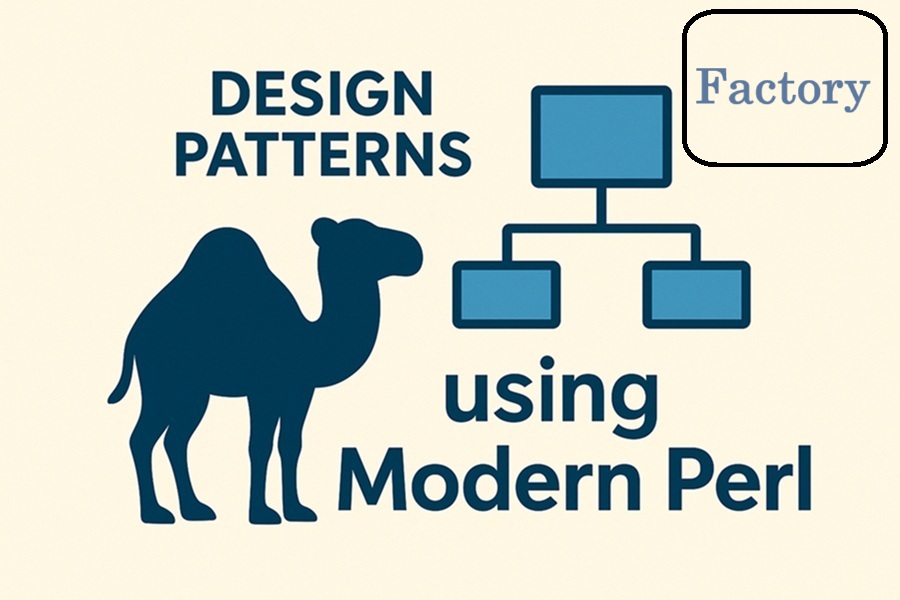DISCLAIMER: Image is generated using ChatGPT.
1. Introduction
2. Define Shape Role
3. Implement Concrete Shapes
4. Create Shape Factory
5. Test Factory
Introduction
In Jan 2021, I created a small project called, Design Pattern using Modern Perl where I explored many design patterns using Moo.
The project became quite popular and received positive feedback on GitHub.
When the experimental class feature was first introduced in Perl v5.38 (released in July 2023, I decided to re-visit the project and re-implement the patterns using this new feature.
However, there was one major blocker, the experimental class feature doesn’t yet support roles.
I waited for some time, but unfortunately, support for roles is not a high priority on the list of outstanding issues.
So, I decided to move forward with what we currently have.
This post is the first in a long series where I’ll be covering commonly used design patterns. Each post will include implementations using both Moo and the new experimental class feature. So you can experience two similar yet distinct approaches.
For consistency, I’ll be using Perl v5.38 as the baseline throughout.
In this post, I’ll demonstrate a simple yet powerful example of the Factory Design Pattern in Perl.
Using Moo, a lightweight object system for Perl, I’ll show how roles and dispatch tables can be combined to produce clean, extensible and testable code.
Specifically, I’ll implement a Shape Factory that can create different types of shapes (Circle, Square, Rectangle) based on a string identifier.
Each shape will implement a common interface, draw, enforced through a Moo role.
Finally, I’ll add unit tests to validate the behaviour.
UPDATE: 2025-09-12, I decided to share the implementation using Object::Pad as well.
Those who are new, it was created by Paul "LeoNerd" Evans. It started as an external CPAN module that used the XS language to add new keywords (class, role, method, has etc.) to Perl. It’s a standalone project that you can choose to use today. The experimental feature class borrowed ideas from it.
Define Shape Role
Let’s create the Shape role using Moo::Role.
package Shape;
use Moo::Role;
requires 'draw';
Moo::Role is similar to a trait or interface.
It declares behaviour that consuming classes must implement.
Here, we say: Any class that does with Shape must provide a draw method.
This ensures consistency: all shapes must know how to "draw themselves".
Let’s do the same using experimental class feature now.
Please note, this isn’t drop-in replacement for Moo version, just workaround until we have support for roles in the class feature.
use experimental 'class';
class Shape {
method draw { die "draw() must be implemented by subclass" }
}
Finally using Object::Pad, this can be your drop-in replacement for Moo version.
use Object::Pad;
role Shape {
method draw;
}
Implement Concrete Shapes
Each shape consumes the Shape role and implements the required draw method.
Again, I’ll create concrete class for each shape using Moo first.
- Uses Moo (to be a full class).
- Consumes the Shape role (with 'Shape').
- Implements draw, returning a string showing which method is being called.
- This makes the interface uniform across all shapes.
package Shape::Circle;
use Moo;
with 'Shape';
sub draw { "Inside Shape::Circle::draw()" }
package Shape::Rectangle;
use Moo;
with 'Shape';
sub draw { "Inside Shape::Rectangle::draw()" }
package Shape::Square;
use Moo;
with 'Shape';
sub draw { "Inside Shape::Square::draw()" }
Let’s do it using class feature.
use experimental 'class';
class Shape::Circle :isa(Shape) {
method draw { "Inside Shape::Circle::draw()" }
}
class Shape::Rectangle :isa(Shape) {
method draw { "Inside Shape::Rectangle::draw()" }
}
class Shape::Square :isa(Shape) {
method draw { "Inside Shape::Square::draw()" }
}
Then with Object::Pad as below:
use Object::Pad;
class Shape::Circle :does(Shape) {
method draw { "Inside Shape::Circle::draw()" }
}
class Shape::Rectangle :does(Shape) {
method draw { "Inside Shape::Rectangle::draw()" }
}
class Shape::Square :does(Shape) {
method draw { "Inside Shape::Square::draw()" }
}
Create Shape Factory
Finally, I’ll create the shape factory using the dispatch table.
The method getShape() accepts a shape name as input. It then looks up the corresponding class in the dispatch table, %dispatch, and returns a new instance of that class.
If the shape isn’t known, it returns undef.
First using Moo.
package ShapeFactory;
use v5.38;
use Moo;
my %dispatch = (
CIRCLE => 'Shape::Circle',
SQUARE => 'Shape::Square',
RECTANGLE => 'Shape::Rectangle'
);
sub getShape($self, $shapeType) {
my $class = $dispatch{ uc $shapeType };
return unless $class;
return $class->new;
}
Then with class feature as below:
use experimental 'class';
class ShapeFactory {
my %dispatch = (
CIRCLE => 'Shape::Circle',
SQUARE => 'Shape::Square',
RECTANGLE => 'Shape::Rectangle'
);
method getShape($shapeType) {
my $class = $dispatch{ uc $shapeType };
return unless $class;
return $class->new;
}
}
Finally using Object::Pad.
use v5.38;
use Object::Pad;
class ShapeFactory {
my %dispatch = (
CIRCLE => 'Shape::Circle',
SQUARE => 'Shape::Square',
RECTANGLE => 'Shape::Rectangle'
);
method getShape($shapeType) {
my $class = $dispatch{ uc $shapeType };
return unless $class;
return $class->new;
}
}
Now, the Factory Pattern is ready for action, the factory hides object creation logic and provides a simple interface for clients.
Test Factory
Here is the standard test script.
use v5.38;
use Test::More;
use ShapeFactory;
my $shapeFactory = ShapeFactory->new;
my $shape1 = $shapeFactory->getShape('CIRCLE');
is($shape1->draw(), 'Inside Shape::Circle::draw()');
my $shape2 = $shapeFactory->getShape('SQUARE');
is($shape2->draw(), 'Inside Shape::Square::draw()');
my $shape3 = $shapeFactory->getShape('RECTANGLE');
is($shape3->draw(), 'Inside Shape::Rectangle::draw()');
my $shape4 = $shapeFactory->getShape('rectangle');
is($shape4->draw(), 'Inside Shape::Rectangle::draw()');
my $no_shape = $shapeFactory->getShape('TRIQUETRA');
ok(! defined $no_shape);
done_testing;
Happy Hacking !!!
